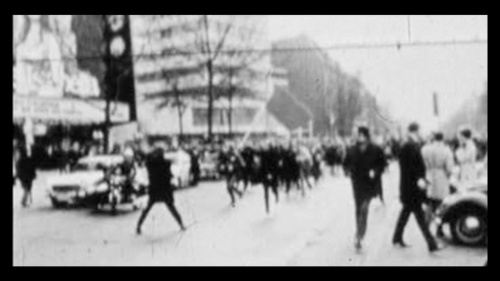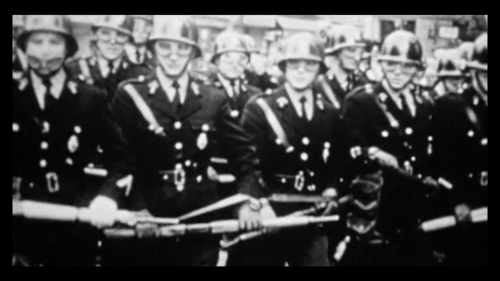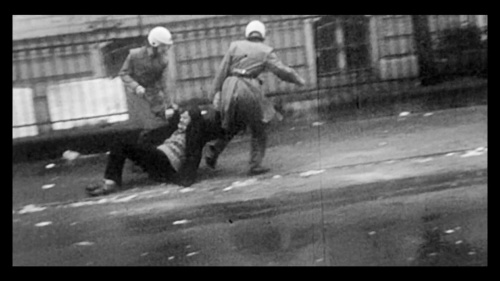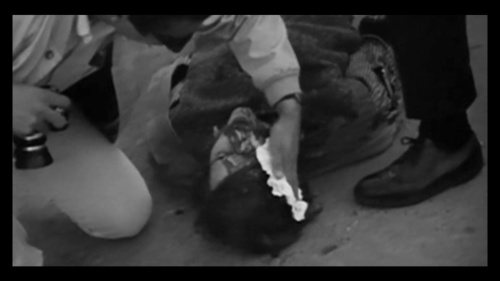The Delicate Art Of The Bludgeon 2009 No Language 1080p WEB-DL x2...

The Delicate Art of the Bludgeon
Documentary
About police men's sensibility.

Year: 2009
Country: France, Philippines
Director: Jean-Gabriel Périot
IMBD: Link
Language : No Language

The police were not created to protect and serve the population. They were not created to stop crime, at least not as most people understand it. And they were certainly not created to promote justice. They were created to protect the new form of wage-labor capitalism that emerged in the mid- to late-19th century from the threat posed by that system’s offspring, the working class.
Before the 19th century, there were no police forces that we would recognize as such anywhere in the world. In the Northern United States, there was a system of elected constables and sheriffs, much more responsible to the population in a very direct way than the police are today. In the South, the closest thing to a police force was the slave patrols.
Then, as Northern cities grew and filled with mostly immigrant wage workers who were physically and socially separated from the ruling class, the wealthy elite who ran the various municipal governments hired hundreds and then thousands of armed men to impose order on the new working class neighborhoods.
Class conflict roiled late-19th century American cities like Chicago, which experienced major strikes and riots in 1867, 1877, 1886, and 1894. In each of these upheavals, the police attacked strikers with extreme violence, even if in 1877 and 1894 the U.S. Army played a bigger role in ultimately repressing the working class. In the aftermath of these movements, the police increasingly presented themselves as a thin blue line protecting civilization (by which they meant bourgeois civilization) from the disorder of the working class. This ideology of order that developed in the late 19th century echoes down to today -except that today, poor black and Latino people are the main threat, rather than immigrant workers.
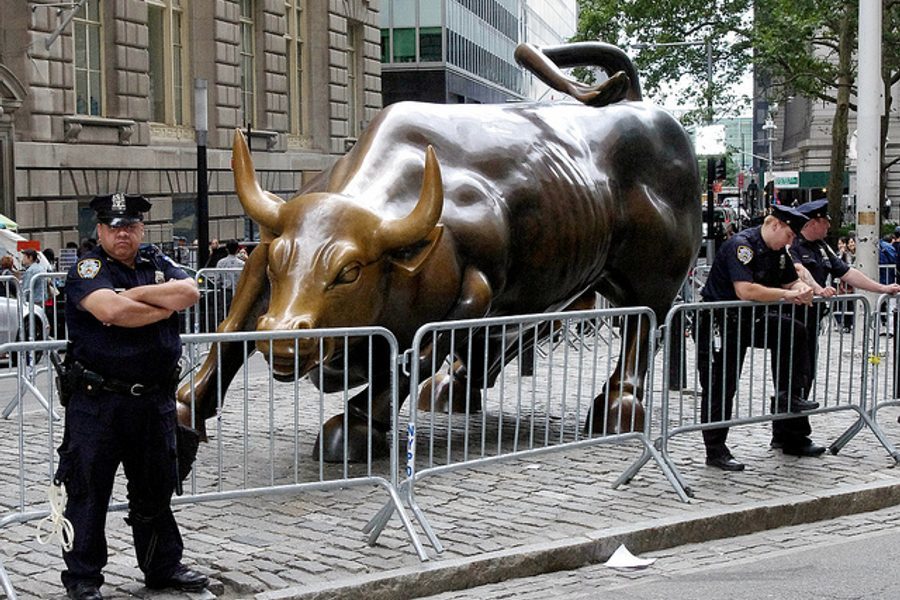
Of course, the ruling class did not get everything it wanted, and had to yield on many points to the immigrant workers it sought to control. This is why, for instance, municipal governments backed away from trying to stop Sunday drinking, and why they hired so many immigrant police officers, especially the Irish. But despite these concessions, businessmen organized themselves to make sure the police were increasingly isolated from democratic control, and established their own hierarchies, systems of governance, and rules of behavior.
The police increasingly set themselves off from the population by donning uniforms; establishing their own rules for hiring, promotion and firing; working to build a unique esprit des corps and identifying themselves with order. And despite complaints about corruption and inefficiency, they gained more and more support from the ruling class, to the extent that in Chicago, for instance, businessmen donated money to buy the police rifles, artillery, Gatling guns, buildings, and money to establish a police pension out of their own pockets.
There was a never a time when the big city police neutrally enforced “the law,” or came anywhere close to that ideal. (For that matter, the law itself has never been neutral.) In the North, they mostly arrested people for the vaguely defined “crimes” of disorderly conduct and vagrancy throughout the nineteenth century. This meant that the police could arrest anyone they saw as a threat to “order.” In the post-bellum South, they enforced white supremacy and largely arrested black people on trumped-up charges in order to feed them into convict labor systems.
The violence the police carried out and their moral separation from those they patrolled were not the consequences of the brutality of individual officers, but were the consequences of careful policies designed to mold the police into a force that could use violence to deal with the social problems that accompanied the development of a wage-labor economy.
For instance, in the short, sharp depression of the mid-1880s, Chicago was filled with prostitutes who worked the streets. Many policemen recognized that these prostitutes were generally impoverished women seeking a way to survive, and initially tolerated their behavior. But the police hierarchy insisted that the patrolmen do their duty whatever their feelings, and arrest these women, impose fines, and drive them off the streets and into brothels, where they could be ignored by some members of the elite and controlled by others.
Similarly, in 1885, when Chicago began to experience a wave of strikes, some policemen sympathized with strikers. But once the police hierarchy and the mayor decided to break the strikes, policemen who refused to comply were fired. In these and a thousand similar ways, the police were molded into a force that would impose order on working class and poor people, whatever the individual feelings of the officers involved.
Though some patrolmen tried to be kind and others were openly brutal, police violence in the 1880s was not a case of a few bad apples and neither is it today.
Much has changed since the creation of the police -most importantly the influx of black people into the Northern cities, the mid-twentieth century black movement, and the creation of the current system of mass incarceration in part as a response to that movement. But these changes did not lead to a fundamental shift in policing. They led to new policies designed to preserve fundamental continuities. The police were created to use violence to reconcile electoral democracy with industrial capitalism. Today, they are just one part of the “criminal justice” system which continues to play the same role. Their basic job is to enforce order among those with the most reason to resent the system -who in our society today are disproportionately poor black people.
A democratic police system is imaginable -one in which police are elected by and accountable to the people they patrol. But that is not what we have. And it’s not what the current system of policing was created to be.
If there is one positive lesson from the history of policing’s origins, it is that when workers organized, refused to submit or cooperate and caused problems for the city governments, they could back the police off from the most galling of their activities.
Murdering individual police officers, as happened in in Chicago on May 3, 1886 and more recently in New York on December 20, 2014, only reinforced those calling for harsh repression -a reaction we are beginning to see already. But resistance on a mass scale could force the police to hesitate. This happened in Chicago during the early 1880s, when the police pulled back from breaking strikes, hired immigrant officers, and tried to re-establish some credibility among the working class after their role in brutally crushing the 1877 upheaval.
The police might be backed off again if the reaction against the killings of Eric Garner, Michael Brown, Tamir Rice and countless others continues. If they are, it will be a victory for those mobilizing today, and will save lives -though as long as this system that requires police violence to control a big share of its population survives, any change in police policy will be aimed at keeping the poor in line more effectively.
We shouldn’t expect the police to be something they’re not. We ought to know that origins matter, and the police were created by the ruling class to control working class and poor people, not help them. They’ve continued to play that role ever since. (Sam Mitrani)

[ About file ]
Name: The Delicate Art Of The Bludgeon.Jean-Gabriel Périot.2009.WEB-DL.mkv
Date: Thu, 03 Dec 2020 12:24:54 +0200
Size: 158,605,754 bytes (151.258234 MiB)
[ Magic ]
File type: Matroska data
File type: EBML file, creator matroska
[ Generic infos ]
Duration: 00:04:00 (240.085 s)
Container: matroska
Production date: Wed, 02 Dec 2020 16:13:37 +0200
Total tracks: 2
Track nr. 1: video (V_MPEG4/ISO/AVC) {und}
Track nr. 2: audio (A_AAC) {und}
Muxing library: libebml v1.3.10 + libmatroska v1.5.2
Writing application: mkvmerge v43.0.0 ('The Quartermaster') 64-bit
[ Relevant data ]
Resolution: 1920 x 1080
Width: multiple of 32
Height: multiple of 8
Average DRF: 13.980173
Standard deviation: 2.306729
Std. dev. weighted mean: 2.261553
[ Video track ]
Codec ID: V_MPEG4/ISO/AVC
Resolution: 1920 x 1080
Frame aspect ratio: 16:9 = 1.777778
Pixel aspect ratio: 1:1 = 1
Display aspect ratio: 16:9 = 1.777778
Framerate: 25 fps
Stream size: 150,920,854 bytes (143.929342 MiB)
Duration (bs): 00:04:00 (240.08 s)
Bitrate (bs): 5029.018794 kbps
Qf: 0.09701
[ Audio track ]
Codec ID: A_AAC
Sampling frequency: 48000 Hz
Channels: 2
Stream size: 7,603,954 bytes (7.251696 MiB)
Bitstream type (bs): AAC LC (Low Complexity)
Frames (bs): 11,254
Duration (bs): 00:04:00 (240.085333 s)
Chunk-aligned (bs): Yes
Bitrate (bs): 253.375044 kbps VBR
Sampling frequency (bs): 48000 Hz
Mode (bs): 2: front-left, front-right
[ Video bitstream ]
Bitstream type: MPEG-4 Part 10
User data: x264 | core 161 r10 4121277 | H.264/MPEG-4 AVC codec
User data: Copyleft 2003-2020 | http://www.videolan.org/x264.html | cabac=1
User data: ref=5 | deblock=1:0:0 | analyse=0x3:0x113 | me=hex | subme=8 | psy=1
User data: psy_rd=1.00:0.00 | mixed_ref=1 | me_range=16 | chroma_me=1
User data: trellis=2 | 8x8dct=1 | cqm=0 | deadzone=21,11 | fast_pskip=1
User data: chroma_qp_offset=-2 | threads=34 | lookahead_threads=5
User data: sliced_threads=0 | nr=0 | decimate=1 | interlaced=0
User data: bluray_compat=0 | stitchable=1 | constrained_intra=0 | bframes=3
User data: b_pyramid=2 | b_adapt=2 | b_bias=0 | direct=3 | weightb=1
User data: open_gop=0 | weightp=2 | keyint=infinite | keyint_min=25
User data: scenecut=40 | intra_refresh=0 | rc_lookahead=50 | rc=crf | mbtree=1
User data: crf=20.0 | qcomp=0.60 | qpmin=5 | qpmax=69 | qpstep=4
User data: vbv_maxrate=5500 | vbv_bufsize=15000 | crf_max=0.0 | nal_hrd=none
User data: filler=0 | ip_ratio=1.40 | aq=1:1.00
SPS id: 0
Profile: High@L4
Num ref frames: 5
Chroma format: YUV 4:2:0
PPS id: 0 (SPS: 0)
Entropy coding type: CABAC
Weighted prediction: P slices - explicit weighted prediction
Weighted bipred idc: B slices - implicit weighted prediction
8x8dct: Yes
Total frames: 6,002
Drop/delay frames: 0
Corrupt frames: 0
P-slices: 2494 ( 41.553 %) ########
B-slices: 3398 ( 56.614 %) ###########
I-slices: 110 ( 1.833 %)
SP-slices: 0 ( 0.000 %)
SI-slices: 0 ( 0.000 %)
[ DRF analysis ]
average DRF: 13.980173
standard deviation: 2.306729
max DRF: 22
DRF<5: 0 ( 0.000 %)
DRF=5: 8 ( 0.133 %)
DRF=6: 127 ( 2.116 %)
DRF=7: 18 ( 0.300 %)
DRF=8: 3 ( 0.050 %)
DRF=9: 167 ( 2.782 %) #
DRF=10: 350 ( 5.831 %) #
DRF=11: 97 ( 1.616 %)
DRF=12: 279 ( 4.648 %) #
DRF=13: 676 ( 11.263 %) ##
DRF=14: 1297 ( 21.609 %) ####
DRF=15: 1532 ( 25.525 %) #####
DRF=16: 1070 ( 17.827 %) ####
DRF=17: 323 ( 5.382 %) #
DRF=18: 50 ( 0.833 %)
DRF=19: 2 ( 0.033 %)
DRF=20: 1 ( 0.017 %)
DRF=21: 0 ( 0.000 %)
DRF=22: 2 ( 0.033 %)
DRF>22: 0 ( 0.000 %)
P-slices average DRF: 13.902967
P-slices std. deviation: 2.401927
P-slices max DRF: 19
B-slices average DRF: 14.137139
B-slices std. deviation: 2.161252
B-slices max DRF: 22
I-slices average DRF: 10.881818
I-slices std. deviation: 2.177287
I-slices max DRF: 15
This report was created by AVInaptic (01-11-2020) on 12-10-2025 17:29:32

